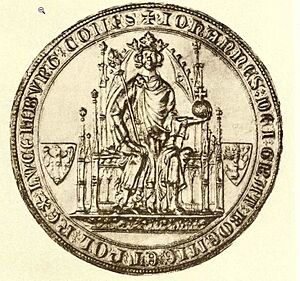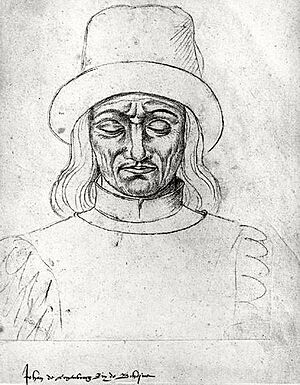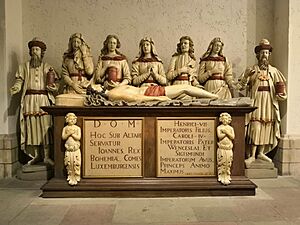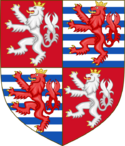John of Bohemia facts for kids
Quick facts for kids John the Blind |
|
|---|---|
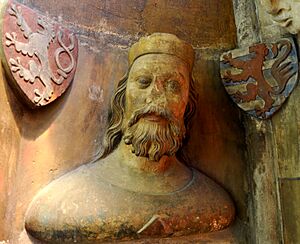
14th-century bust of John of Bohemia, St. Vitus Cathedral in Prague with the coat of arms of Bohemia and Luxembourg
|
|
| King of Bohemia | |
| Reign | 31 August 1310 – 26 August 1346 |
| Coronation | 7 February 1311, Prague |
| Predecessor | Henry |
| Successor | Emperor Charles IV |
| Count of Luxembourg, Arlon and Durbuy | |
| Reign | 24 August 1313 – 26 August 1346 |
| Predecessor | Emperor Henry VII |
| Successor | Emperor Charles IV |
| Born | 10 August 1296 Luxembourg |
| Died | 26 August 1346 (aged 50) Crécy-en-Ponthieu |
| Burial | Altmünster Abbey, Luxembourg |
| Spouse | |
| Issue |
|
| House | Luxembourg |
| Father | Henry VII, Holy Roman Emperor |
| Mother | Margaret of Brabant |
John the Blind, also known as John of Luxembourg, was a brave ruler who lived from 1296 to 1346. He was the Count of Luxembourg from 1313 and the King of Bohemia from 1310. He was also called the King of Poland, though this was just a title.
John is famous for fighting and dying in the Battle of Crécy when he was 50 years old. He had been blind for ten years before this battle. In his home country of Luxembourg, he is seen as a national hero. In the Czech Republic, people remember him as the father of Charles IV, Holy Roman Emperor. Charles IV became one of the most important kings of Bohemia and a leading Holy Roman Emperor.
Contents
Early Life and Becoming King
John was the oldest son of Henry VII, Holy Roman Emperor, and Margaret of Brabant. He was born in Luxembourg and grew up in Paris, France. Even though he was educated in France, he was very involved in German politics.
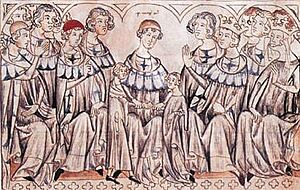
In 1310, when John was 14, his father arranged for him to marry Elizabeth of Bohemia. Their wedding happened in Speyer. After the wedding, John and Elizabeth traveled to Prague. They were joined by a group led by Peter of Aspelt, a skilled diplomat.
John had to invade Bohemia to help his wife Elizabeth. His forces took control of Prague and removed the current king, Henry of Gorizia, on December 3, 1310. John and Elizabeth were crowned King and Queen of Bohemia on February 7, 1311. John helped bring stability to the Czech state. This made him one of the seven prince-electors of the Holy Roman Empire. These electors chose the Holy Roman Emperor.
John also claimed the thrones of Poland and Hungary. He tried to become King of the Romans, like his father, but Louis IV of Bavaria was chosen instead in 1314. John later supported Louis IV in a conflict, and in return, he received the Czech region of Egerland.
Challenges with Nobility
Many of the Czech nobles did not like John, just like they disliked the king before him. They saw John as an "alien king." After a while, John gave up managing Bohemia and traveled a lot. He separated from his wife and let the nobles rule the Czech country. He spent time in Luxembourg and at the French court.
John traveled to many places, including Silesia, Poland, and Lithuania. He was a rival to King Władysław I the Elbow-high for the Polish crown. John supported the Teutonic Knights in a war against Poland from 1326 to 1332. He also made several Silesian dukes promise loyalty to him.
In 1335, at the Congress of Visegrád, King Casimir III the Great of Poland paid John a large sum of money. In exchange, John gave up his claim to the Polish throne.
When John first became king, he tried to bring peace and order to Bohemia. In 1311, he made an agreement with the Bohemian and Moravian nobles. This agreement limited the power of both the ruler and the nobles. The nobles kept the right to choose the king and decide on special taxes. They also had the right to their property and could choose whether to help the king in foreign wars. However, they were encouraged to raise armies if peace in the country was threatened. The king could no longer appoint foreign officials.
These agreements were meant to help the king gain more power. But they didn't work as well as John hoped. The nobles did not want to give up the power they had gained.
Because John was often away from Bohemia, tensions grew among the nobles. Two groups of Czech nobles began to compete. One group, led by Jindřich of Lipá, gained John's trust. The other group, led by Vilém Zajíc of Valdek, convinced the Queen that Lord Lipá planned to overthrow John. So, in 1315, John had Jindřich put in prison.
By 1318, John had made peace with the nobles. He recognized their rights, which meant power was shared between the king and the nobles.
International Influence
John was very good at foreign politics, and he preferred it over Czech affairs. With his father's help, John convinced the Habsburgs to agree on matters concerning Moravia. He also pressured the House of Wettin, princes of Saxony, to give up land near the Czech border. John also worked to improve relations with the Silesian areas close to Bohemia and Moravia.
John's father also made him an Imperial Vicar. This meant John was his father's helper in ruling the Empire. This allowed John to get involved in more international matters. He helped with the emperor's coronation and with ending wars in Italy.
In 1313, John's father died suddenly. This opened up a chance for John to become the Holy Roman Emperor. The other main candidates were Fredrick of Habsburg and Louis of Bavaria. John chose to support Louis. In return, Louis, as the new emperor, promised to support the Czech state's land claims in Silesia and Meissen. He also gave John the regions of Cheb and the Upper Palatinate. Later, John gained control over the Bautzen region in 1319 and the Görlitz region in 1329.
By 1322, King John became worried about Louis's growing power. He then allied with France and Austria against Louis. This conflict grew, and John's son Charles later claimed the Imperial crown against Louis.
Death in Battle
John lost his eyesight around age 39 or 40 in 1336. This was due to a serious eye infection called ophthalmia. A famous doctor named Guy de Chauliac tried to help, but it didn't work.
When the Hundred Years' War began in 1337, John joined forces with King Philip VI of France. He was even made governor of Languedoc for a few years.
At the Battle of Crécy in 1346, John led part of the French army. He was killed while fighting against the English during the battle. He was 50 years old. The medieval writer Jean Froissart wrote about John's last actions:
...even though he was almost blind, when he understood the battle plan, he asked those around him: 'Where is my son Charles?' His men said: 'Sir, we don't know; we think he is fighting.' Then he said: 'Sirs, you are my men, my friends in this journey: I ask you to lead me forward so I can strike one blow with my sword.' They said they would do what he asked. So they tied all their horses' reins together and put the king in front to fulfill his wish, and they went towards their enemies. Lord Charles of Bohemia, his son, who called himself King of Germany and carried the arms, came in good order to the battle; but when he saw that things were going badly for their side, he left, I cannot tell you which way. The king, his father, went so far forward that he struck one blow with his sword, yes, and more than four, and fought bravely, as did his company; and they risked themselves so much that they were all killed there. The next day they were found around the king, with all their horses tied together.
Another old record says that when John's helpers told him the battle was lost and he should run away, John the Blind replied: "Far be it that the King of Bohemia should run away. Instead, take me to the place where the noise of the battle is the loudest. The Lord will be with us. Nothing to fear. Just take good care of my son. "
John's oldest son, Charles, became King of Bohemia after him. In Luxembourg, his son Wenceslaus (from his second marriage) became the new ruler.
Burial Place
John the Blind's body was first buried at Kloster Altmünster in Luxembourg. When that abbey was destroyed in 1543, his body was moved to Kloster Neumünster in Luxembourg.
During the French Revolution, a family named Boch, who owned an industry, saved his remains. They hid his body in an attic room in Mettlach. It is said that the monks of the abbey asked them for this favor.
In 1833, John-François Boch, a member of the Boch family, met the future King Frederick William IV of Prussia. He offered John's remains as a gift. Since Frederick William was a descendant of John the Blind, he ordered a special funeral chapel to be built. The chapel was built in 1834 and 1835 near Kastel-Staadt. In 1838, John the Blind was placed in a black marble sarcophagus in a public ceremony.
In 1945, the government of Luxembourg managed to get John's bones back. In a secret operation, his remains were moved to the crypt of the Notre-Dame Cathedral, Luxembourg. The words on his tomb say: "Here lies John, King of Bohemia, Count of Luxembourg, son of Emperor Henry VII, father of Emperor Charles IV, grandfather of Emperors Wenceslaus and Sigismund, a prince of great spirit, died August 30, 1340." (Note: The death date on the tomb is incorrect, he died in 1346).
Family and Children
John was married two times:
First, he married Elisabeth of Bohemia. She was the daughter of King Wenceslaus II of Bohemia. They had these children:
- Margaret of Luxembourg, Duchess of Bavaria (1313–1341). She married Henry XIV, Duke of Bavaria.
- Bonne of Luxembourg, Duchess of Normandy (1315–1349). She married John, Duke of Normandy, who later became King John II of France.
- Charles IV of Luxembourg (1316–1378). He became King of Bohemia and later the Holy Roman Emperor.
- Ottokar ("Otto") (1318–1320).
- John Henry of Luxembourg (1322–1375). He was the Margrave of Moravia.
- Anna of Luxembourg, Duchess of Austria (1323–1338). She married Otto, Duke of Austria.
- Elizabeth (1323–1324).
Second, in December 1334, he married Beatrice of Bourbon. She was the daughter of Louis I, Duke of Bourbon. They had one son:
- Wenceslaus I of Luxembourg (1337–1383). He became Duke of Luxembourg and later Brabant.
John also had an illegitimate son named Nicolaus. He became the Patriarch of Aquileia from 1350 to 1358.
See also
 In Spanish: Juan I de Bohemia para niños
In Spanish: Juan I de Bohemia para niños


